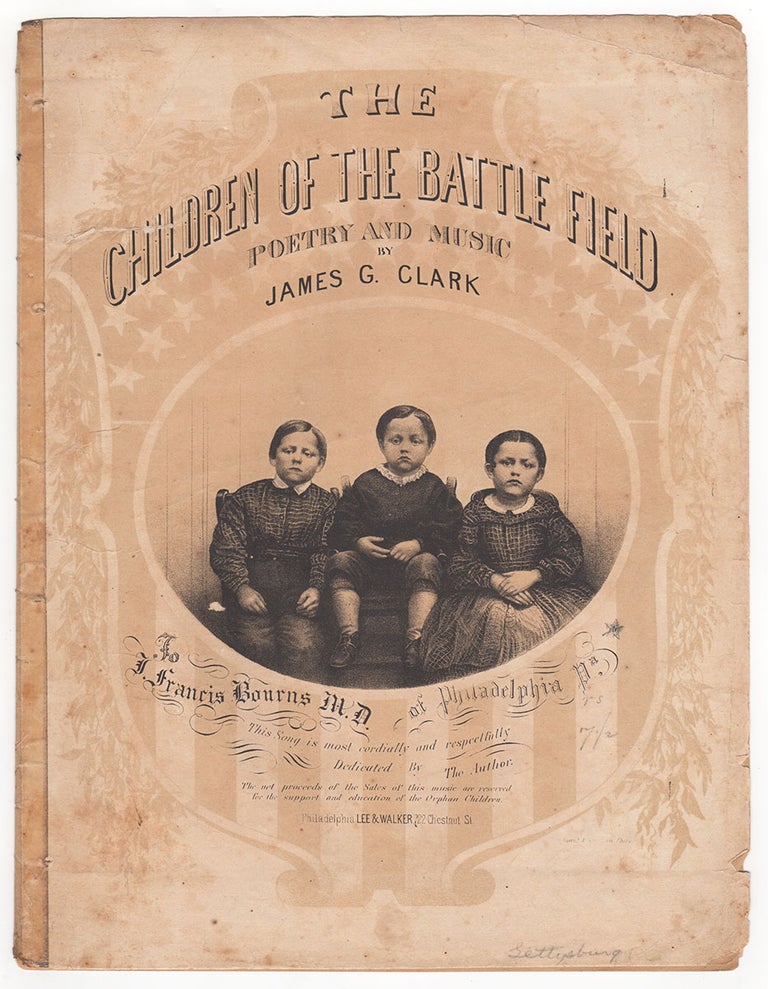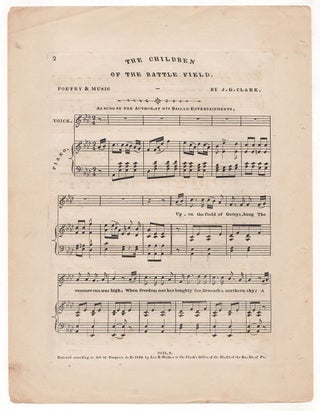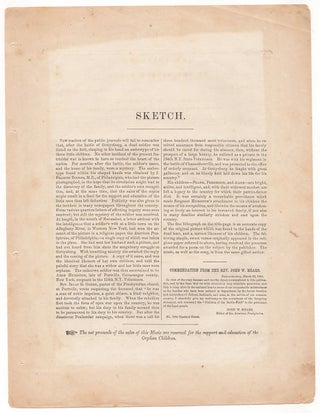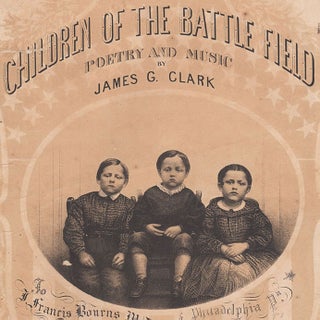The Children of the Battle Field.
Philadelphia: Lee & Walker, 1864. 4to sheet-music (350 x 270 mm), lithographic front cover, ads on back cover. 4 loose pp., as issued(?). Scarce sheet music sold for the benefit of three children orphaned by the Battle of Gettysburg, illustrated with a lithograph based on an ambrotype portrait of the children found in their dead father’s hand. The music is preceded by a Sketch describing the melancholic scene of the slain and unidentified soldier’s body found on the fields of Gettysburg clasping the ambrotype. The Sketch notes that “few readers of the public journals will fail to remember” this scene—“no other incident of the present fratricidal war is known to have so touched the heart of the nation.” The ambrotype came into the possession of one J. Fancis Bourns, M.D. of Philadelphia, who had traveled to Gettysburg to tend to the wounded. In turn, Bourns reproduced the ambrotype in The Philadelphia Inquirer, hoping that its greater circulation would lead to the discovery of the family, identification of the slain soldier, and even perhaps the funding of the fatherless family. Numerous newspapers throughout the country publicized the story, and in time the family was identified as that of Sgt. Amos Humiston, from Portville, New York, a sergeant in the 154th New York Volunteers. A note appears on the title and sketch pages reading “the net proceeds of the sales of this Music are reserved for the support and education of the Orphan Children.” The Children of the Battle Field, intended to be played by piano and voice, bears the musical directive: “as sung by the author, at his ballad entertainments.” The lyrics begin thus:
Up - on the field of Gettys - burg The summer sun was high, When freedom met her haughty foe, Beneath a northern sky; A - mong the he-roes of the North, Who swelled her grand ar-ray, And rushed like moun - tain eagles forth From happy homes a - way. There stood a man of humble fame, A sire of children three, And gazed within a little frame, Their picture form to see. And blame him not, if in the strife, He breathed a soldier’s prayer: O Father, shield the soldier’s wife, And for his children care, And for his chil-dren care.
The front cover notes that “this song is most cordially and respectfully dedicated by the author to J. Francis Bourns M.D. of Philadelphia.” John W. Mears Editor of the American Presbyterian offers the following commendation:
In view of the very humane and worthy object contemplated in this publication, and in the hope that its wide circulation may stimulate patriotism and help keep alive in the national heart a sense of the unspeakable indebtedness to the families who have been reduced to dependence by the heroic devotion and martyrdom of fathers, husbands, and sons, in the service of our common country, I cheerfully give my testimony to the correctness of the foregoing statement [the Sketch], and commend the “Children of the Battle Field” to the patronage of the loyal people.
An especially poignant example of Civil War sheet music.
CONDITION: Old tape repair to spine, old paper reinforcement to inner edges of covers, bit of foxing, back cover upside down.
REFERENCES: Morris, Errol. Whose Father Was He? (Part One) at nytimes.com
Item #4621
Sold





